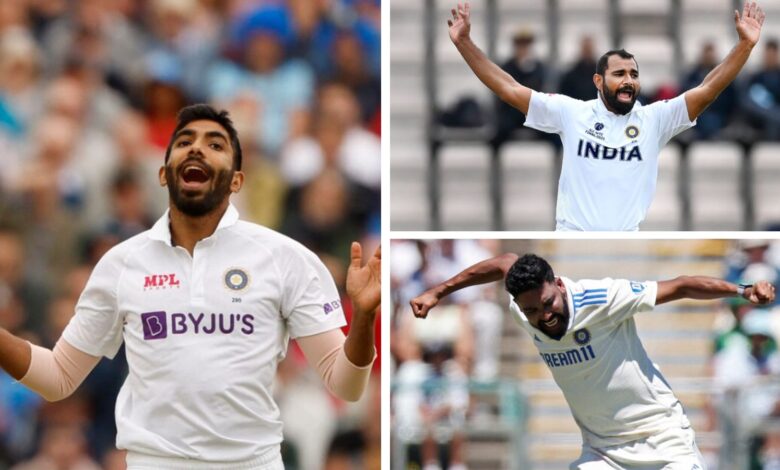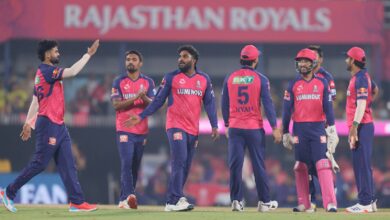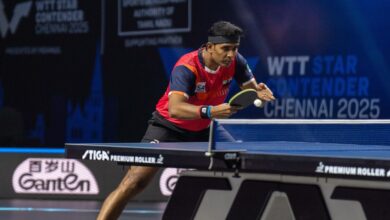India’s fast bowling crisis: Who is battle-ready to back up Bumrah, Shami, and Siraj? | Cricket News

As the pacer Navdeep Saini and Gaurav Yadav replace Mohammad Siraj and Umran Malik respectively from Duleep Trophy squads, it’s a good time as any to raise a question as India aim a third ICC World Test Championship (WTC) final: Is there an underlying crisis within India’s Test set-up?Should Rohit Sharma’s team make next year’s WTC final at Lord’s, they would have competed in 16 Tests (11 overseas) August 2025. The main cast appears steady. However, the absence of backup seamers, equipped to take flight in foreign conditions, is a dending concern as the marathon begins in September.
With Jasprit Bumrah rested, Mohammad Shami yet to regain full fitness and Siraj out ill, the national selectors have gone all-out in picking 21 seam-bowling options, with mixed international and First-Class experience for the upcoming Duleep Trophy. The red-ball tournament, which has borne nominal value for years, arrives as a timely laboratory to whittle down the pacers before the Bangladesh and New Zealand Tests and the blockbuster Border-Gavaskar Trophy in Australia in November.
Bumrah, Shami (fitness subjective) and Siraj will form the crux of India’s pace department for their first five-match Test series in Australia in three decades. Pause and reflect on their backups for a moment. The fourth and fifth seamers? Hazy.
“It’s a question of identifying the right ones and giving them opportunities to be ready for the Australian trip. There are lots of bowlers who hit 140-150 kph in the IPL. So it is about nurturing and giving them the right exposure,” former India bowling coach Bharat Arun tells The Indian Express.
Duleep Trophy Round 1 pacers
Player
FC Season
Balls bowled
Wickets
BBI
Ave
5w
10wm
Akash Deep
2019-20 onwards
4966
107
6-60
23.7
4
1
Prasidh Krishna
2019-20 onwards
1256
38
6-35
17.76
2
1
Avesh Khan
2019-20 onwards
4348
106
7-38
21.37
5
1
Mukesh Kumar
2019-20 onwards
5372
118
6-32
20.3
5
1
Khaleel Ahmed
2019-20 onwards
1271
20
4-19
31.25
–
–
Umran Malik
2021-22 onwards
1034
16
3-25
44.62
–
–
Arshdeep Singh
2019-20 onwards
2932
49
5-33
31.97
1
–
Vidwath Kaverappa
2021-22 onwards
3610
80
7-53
20.08
5
1
Gourav Yadav
2019-20 onwards
4554
114
7-49
21.85
7
2
Nitish Kumar Reddy
2022-23 onwards
2125
50
5-53
22.44
2
–
Yash Dayal
2019-20 onwards
2701
42
5-48
30.38
1
–
Vijaykumar Vyshak
2021-22 onwards
3769
86
5-59
23.5
3
–
Mohit Avasthi
2021-22 onwards
2895
72
7-52
21.83
4
1
Sandeep Warrier
2019-20 onwards
4257
76
5-68
28.43
2
–
Himanshu Chauhan
2023-24 onwards
1161
30
5-39
18.76
3
–
Anshul Kamboj
2022-23 onwards
1716
24
3-24
38.91
–
–
Tushar Deshpande
2019-20 onwards
3259
59
5-37
31.38
2
–
Aditya Thakare
2019-20 onwards
2872
62
7-55
20.82
4
–
Harshit Rana
2022-23 onwards
1107
28
7-45
26.35
1
1
Akash Sengupta
2022-23 onwards
1200
12
3-136
66.41
–
–
Navdeep Saini
2019-20 onwards
3369
64
5-72
31.25
2
–
Shivam Dube
2019-23 onwards
496
13
4-10
15.38
–
–
Riches or pipe dreams?
Since January 2020, India have played 30 seam bowlers across all formats. Thirteen of them featured in at least one Test. 11 of these 13 bowlers played in overseas conditions, but only six of these pacers remain in the system heading into the 2024-25 season.
Ishant Sharma’s career halted at 105 Tests in 2021. Umesh Yadav, 36, last featured in the home 2023 WTC final against Australia. Shardul Thakur, currently out injured, seems to have lost favour after a poor South Africa trip last year. T Natarajan faded out and Jaydev Unadkat briefly reappeared after 12 years in 2022.
Since January 2020, India have played 30 seam bowlers across all formats. Thirteen of them featured in at least one Test. (Source: AP)
In this recession and transition, India have fielded three pacers – Mukesh Kumar, Prasidh Krishna and Akash Deep – in rotation for a combined six Tests in 2023-24. They remain firmly in contention to make the squad for the Australia tour and beyond.
Bharat inss that India still have some leeway for preparation but emphasises the necessity of red-ball overs.
“There must be a first time. Red ball cricket is something these bowlers must get used to. We have time but we need to prepare giving them enough overs under their belt.”
With Siraj out of the Duleep Trophy first round due to illness, the Test match experience of the pacers on the show is negligible.
The Bengal duo of Mukesh and Akash come the closest, having sent down 895 and 827 overs respectively since 2019-20. Madhya Pradesh’s Avesh Khan, yet to make his Test debut, has also been a consent presence at the first-class level, recording 106 wickets in 750 overs. Avesh also received exposure to conditions in England, West Indies, and South Africa through the India A system, similar to Siraj’s domestic grind.
The Hyderabad pacer bowled more than 1112 overs across six seasons and 40 first-class matches before India’s 2020-21 Australia tour. Siraj was also battle-hardened with quality India A hours across continents and claimed 150 wickets before his Test debut on Boxing Day in Melbourne in 2020. He picked up 13 wickets in the series, including a five-wicket haul and emerged as India’s leading wicket-taker.
Span
Balls bowled
Wickets
BBI
Ave
5w
10wm
Mohammed Siraj
FC before Test debut (2015-20)
6837
152
8-59
22.11
4
2
Tests – 2020-21 onwards
3930
74
6-15
29.68
3
–
Jasprit Bumrah
FC before Test debut (2013-17)
5014
89
5-52
25.34
6
–
Tests – 2017 onwards
7182
159
6-27
20.69
10
–
Mohammad Shami
FC before Test debut (2010-13)
3689
97
7-79
19.78
3
2
Tests – 2013 onwards
11515
229
6-56
27.71
6
–
Credited with having spotted a young Siraj, who presumably is the last genuine product from the India A system, Bharat explains the vitality of his immense FC background. “Bowling in first-class cricket, you bowl on unresponsive pitches. You have to come out with some guile or you would need to learn how to reverse the ball because of the conditions that ex in our country. I think it helped Siraj and Shami a great deal. That’s why when the conditions are right and the ball is reversing, Siraj is probably one of the most dangerous bowlers in world cricket.”
Following the confluence of Bumrah-Shami-Siraj alongside Ishant, Umesh and Bhuvneshwar Kumar to an extent, India are treading on thin ice where the white-ball faithful are automatically earmarked for a red-ball crossover. Nothing explains this trend more than the spurt of Khaleel Ahmed, Umran Malik, Yash Dayal and Shivam Dube (for want of an all-rounder) back into the Duleep Trophy with negligible first-class contributions in the last five years.
Credited with having spotted a young Siraj, who presumably is the last genuine product from the India A system, Bharat Arun explains the vitality of his immense FC background. (PTI Photo)
In South Africa last year, India attempted to inject ‘pace and bounce’ through Prasidh Krishna. The Karnataka seamer had a forgettable tour, finishing with 2 wickets in as many games at a 65 average and was later sidelined injury. Prasidh was being backed for his attributes and relatively smoother initiation to internationals through ODIs and T20Is. However, his limited red-ball bowling load – an inadequate 1256 balls since 2019 – could have made it difficult for Prasidh to manoeuvre on the Centurion and Newlands strips.
The favourites?
Left-armer Arshdeep Singh and speedster Umran were also regarded among the early favourites to make the Test backup l. Umran, who made his FC debut in South Africa after bursting into the spotlight through the IPL, has bowled only 1034 balls in the format and has yet to pick more than three wickets in an innings. An untimely illness will also keep him out from the first round of the Duleep Trophy.
“Umran is a classic case of who has not played enough red-ball cricket. He came to the reckoning through the IPL. That’s 24 balls in a game. Sometimes you don’t even get to bowl 24 balls. The amount of pressure of bowling 24 balls is not like the red ball. I feel this (T20) is not a format to judge a prospect,” Paras Mhambrey, India’s bowling coach between 2021-2024, tells The Indian Express.
“We made sure that he played Ranji Trophy and red ball cricket. The moment you will play one season, you will understand your bowling. Physically you will be tested in different phases of the game. Sometimes you will have to be on the ground for six sessions. And to be able to bowl with that intensity when the last session is coming up, you will be physically and mentally challenged. And you need to go through that,” Mhambrey explains.
Fresh from the T20 World Cup triumph, Arshdeep is backed for an extended run in whites. (AP | PTI)
“Injuries might come if you are not bowling enough as well. Your body is not able to take that load and it will give up. But in Umran, Mayank and Kuldeep’s (Sen) case, the bowlers who can pump it up to 145 kph, will have injuries. I don’t think any bowler who steps onto the field can stay away from injuries but for that, we have trainers and the physios. But they will have to bowl,” Mhambrey stresses.
Fresh from the T20 World Cup triumph, Arshdeep is backed for an extended run in whites. While he is already a T20I ace with 83 wickets, the Punjab bowler has only played a handful of Ranji and County games with ordinary returns. But his commitment to more game time stands out from most, according to Mhambrey.
“T20 is a high-pressure game and he was bowling in the Powerplay and the death overs, so the ability to soak up the pressure was there. A left-armer can give you a different angle. We saw the potential and wanted Arshdeep in the scheme. Credit must go to him that he wants to play more. Most players are shying away from playing the format now,” he observes.
Obsession continues to fuel the engine room. “In white-ball cricket, you get instant rewards. Test cricket is a hard grind. You need someone who likes to play red-ball cricket. You see the likes of Bumrah, Shami and Siraj and how much they enjoy playing Test cricket,” says Mhambrey.
FC performers to miss out
Player
Season
Balls bowled
Wickets
BBI
Ave
5w
10wm
Jaydev Unadkat
2019-20 onwards
4572
121
8-39
21.85
9
3
Baltej Singh
2019-20 onwards
4159
98
7-28
18.26
6
2
Manisankar Murasingh
2019-20 onwards
5233
116
7-63
20.51
9
2
V Koushik
2019-20 onwards
3235
70
7-41
16.94
2
–
Vaibhav Arora
2019-20 onwards
3588
88
6-48
22.35
4
–
Suraj Jaiswal
2023-24 onwards
926
31
6-124
13.06
2
–
Punts and questions
There are other bittersweet variances in the selectors’ choices. Like Sandeep Warrier’s return to the fold at 33. Consent throughout his red-ball stints with Kerala and Tamil Nadu, Warrier has nevertheless shone with 51 wickets in the last two seasons. Meanwhile, the 32-year-old Unadkat, a workhorse who has snapped up almost 150 wickets since 2019, was ignored.
The other themes are of genuine promise and random flips of the dice.
Karnataka’s Vidwath Kaverappa and Vyshak Vijaykumar (left and centre) are the other consent picks on the radar. (File)
In Nitish Kumar Reddy, the management sees a Hardik Pandya clone. Rising from the junior level as a tempered batter, Nitish has grown into his role as Andhra’s seam spearhead, notching up 50 wickets in the previous two Ranji seasons.
Delhi’s 21-year-old Himanshu Chauhan is also among the bright prospects to watch. During a patch of unending misery for Delhi, the burly seamer blighted oppositions with his skiddy pace, touching 140 kph and nabbing 30 wickets in seven matches. Himanshu’s better-known statemate, Harshit Rana, has charted his way through L A and IPL exploits and the thrill of speed. But Rana has only played seven FC matches and none since last year’s Duleep Trophy.
Gaurav Yadav, the highest wicket-taking (41) pacer of the 2023-24 Ranji season would not have made the cut if not for Umran’s unavailability. The former Madhya Pradesh bowler has racked up 114 Ranji wickets over the last four seasons.
Vidwath Kaverappa and Vyshak Vijaykumar are the other consent picks on the radar, both running laudable streaks since their Karnataka debuts. While Kaverappa makes the most of a high-arm action, often generating appreciable bounce with nagging control, he is short on pace, unlike Vyshak.
Mumbai’s Mohit Avasthi and Vidarbha’s Aditya Thakare have entered the long run of hopefuls on the back of recent Ranji showings, while Assam’s Akash Sengupta and Haryana pacer Anshul Kambhoj were picked for reasons best known to the selectors, not necessarily on the parameter of red-ball numbers.
Instinctive to every selectorial procedure, an unfortunate lot has slipped through the cracks of the stop-start nature of transition projects in Indian cricket. Baltej Singh, Manisankar Murasingh, V Koushik, and many more will head into another season of unglamorous hauls in white trousers, even as the country’s Test pace battery is sounding a whimper of running dry.





